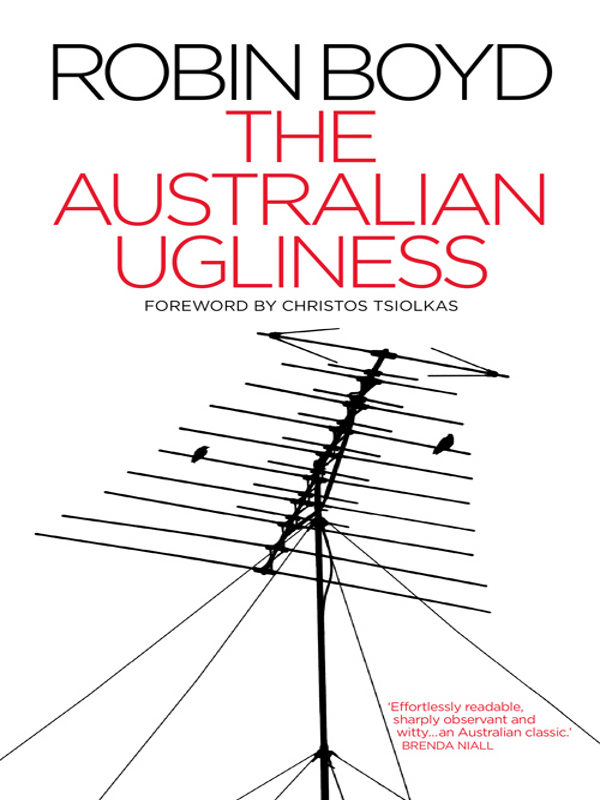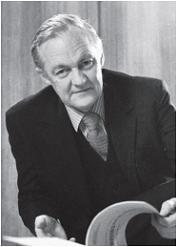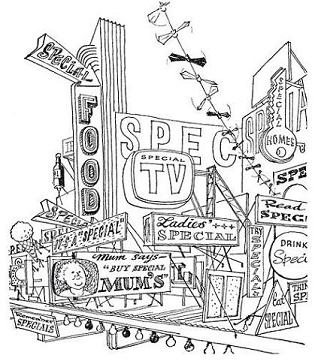The Australian Ugliness


THE AUSTRALIAN UGLINESS
PRAISE FOR ROBIN BOYD
AND
THE AUSTRALIAN UGLINESS
âEffortlessly readable, sharply observant and witty,
The Australian Ugliness
is an Australian classic. Robin Boyd's prophetic, timeless work shows his distinctive gifts as a public intellectual, a creative thinker, an architect with a sense of history and a writer of rare talent.' BRENDA NIALL
âRobin Boyd was a social historian when political history was the vogue in Australia. He was a long way ahead of his time. The natural and built environments were not yet issues of common concern, but they were already his special concern. Whatever he did had the mark of originality and flair.' GEOFFREY BLAINEY
â
The Australian Ugliness
remains an indispensible account of the built environment on the biggest island. More than that, it is a passionate and committed study of national character from which there is still much to be learned.' ALAN SAUNDERS
âRobin Boyd's
The Australian Ugliness
is a classic of cultural criticism. Judging by the unstoppable spread of treeless, wooden-fenced houses in outlying suburbs and bad buildings in prominent places in Australian cities, it's a voice that needs urgently to be heard again.' PATRICK McCAUGHEY
âIncisive witâ¦Boyd portrays most eloquently Australian suburbia⦠the merciless bulldozing of trees to turn farmland around our cities into the endless, low-density sprawl of individual house subdivisions.' HARRY SEIDLER
â
The Australian Ugliness
remains a most important book. As our major metropolises near five million population, the suburban sprawl with unimaginative architecture creeps on relentlessly and green wedges shrink. Bold new ideas are needed and Robin Boyd continues to be an inspiration.' SIR GUSTAV NOSSAL
âRobin Boyd's book clarified for all of us that Australian uglinessâhow we would bludgeon the land into fertility, cut forests so that power lines could go through, so that cars could take precedence over everything⦠Conservatism reigned supreme; it had to be like that regardless of whether it was logical, whether it was appropriate, whether it responded to climatic variationsâ¦The buildings were the same from Melbourne to Darwin, and they still are the same.' GLENN MURCUTT
âFifty years on, Robin Boyd's brilliant analysis of the enduring, yet underappreciated, place of the arts and creativity in Australia rings true. He suggests there is “something about the Australian sun and meaty diet that produces a high proportion of talented people”. The continuing international success of our artists, actors and architects proves this. But, as Boyd argued, we need to value creativity more: it is an essential part of the spirit of Australia.' JULIANNE SCHULTZ
âRobin Boyd wrote wittily of the post-war Australian suburbia that Barry Humphries knew as a child, and which formed the basis of much of Humphries' satire and, in turn, the satire of
Kath & Kim
. Boyd's waspish observations about the “material triumph and aesthetic calamity” of the suburbs apply more than ever today.' SIMON CATERSON
âRemains remarkableâ¦for Boyd, architecture means more than the fabrication of shelters: it is the art that most explicitly measures humanity's relationship to natureâ¦His book is less a work of architectural criticism than a scathing literary satire; it belongs in a tradition inaugurated in the eighteenth century by Pope and Swift, who also scourged ugliness and considered it a moral flaw as well as an aesthetic failing.' PETER CONRAD
âAs interesting and amusing and untechnical as a novel.' SIR JOHN BETJEMAN
âLucid, passionate and witty.' GEOFFREY SERLE

ROBIN BOYD, 1970.
PHOTOGRAPH BY MARK STRIZIC.
ROBIN BOYD (
1919â71
) is arguably Australia's most influential architect.
An idealist who believed that good design would improve the quality of people's lives, a tireless public educator and outspoken social commentator, he designed more than two hundred buildings and wrote such classics as
Australia's Home
.
The Australian Ugliness
was first published in
1960
.
CHRISTOS TSIOLKAS is the author of four novels:
Loaded
(made into the film
Head On
),
The Jesus Man
,
Dead Europe
and the award-winning bestseller
The Slap
, which is being made into a series by the ABC.
JOHN DENTON is a Director of Denton Corker Marshall, a proudly Australian international architecture and urban design practice with offices in Melbourne, London and Jakarta. PHILIP GOAD is Professor and Chair of Architecture, and Director of the Melbourne School of Design, at the University of Melbourne. GEOFFREY LONDON is the Professor of Architecture at the University of Western Australia and the Victorian Government Architect, having previously been the Western Australian Government Architect.
THE
AUSTRALIAN
UGLINESS
ROBIN BOYD
FOREWORD BY CHRISTOS TSIOLKAS
AFTERWORD BY JOHN DENTON,
PHILIP GOAD & GEOFFREY LONDON
DRAWINGS BY ROBIN BOYD

TEXT PUBLISHING MELBOURNE AUSTRALIA
The paper used in this book is manufactured only from
wood grown in sustainable regrowth forests.
The Text Publishing Company
Swann House
22 William Street
Melbourne Victoria
3000
Australia
www.textpublishing.com.au
Copyright © Robin Boyd
Foundation
2010
Foreword copyright © Christos Tsiolkas
2010
Afterword copyright © John Denton, Philip Goad & Geoffrey London
2010
All rights reserved. Without limiting the rights under copyright above, no part of this publication shall be reproduced, stored in or introduced into a retrieval system, or transmitted in any form or by any means (electronic, mechanical, photocopying, recording or otherwise), without the prior permission of both the copyright owner and the publisher of this book.
First published in
1960
by F. W. Cheshire, Melbourne; second edition,
1961.
Published in
1963
by Penguin Books; revised edition,
1968;
second revised edition,
1980.
This fiftieth-anniversary edition published in
2010
by The Text Publishing Company.
Cover and text design by W. H. Chong
Typeset in Granjon by J&M Typesetting
Printed in Australia by Griffin Press
National Library of Australia Cataloguing-in-Publication data:
Boyd, Robin,
1919-1971.
The Australian ugliness / Robin Boyd.
ISBN
9781921656224
Architecture--Australia. Architecture and society--Australia.
National characteristics, Australian.
720.994
âIt is taken for granted that Australia is uglyâ¦'
ANTHONY TROLLOPE

CONTENTS
Christos Tsiolkas
8 The Ethics of Anti-Featurism
John Denton, Philip Goad & Geoffrey London
Christos Tsiolkas
A few years ago I was sitting in a friend's apartment in Barcelona. She was living on a small street off the Parc de la Ciutadella, near the Arc de Triomf, walking distance from the tourist mecca of the Barri Gòtic. It seemed full of old-world character, with rows of ramshackle working-class apartments that housed the city's immigrant population. Every evening we would hear music outside on the street: the frenetic beating of drums; the call and response of English- and Spanish-language hip-hop; the chanting of the Call to Prayer. Music, motion, life lived on the streetsâeverything missing, I said, from our cities back home. My friend, an expat, nodded her head in agreement at my criticisms of Australian suburbia. But a Catalan colleague of hers who had joined us for a drink rolled her eyes in frustration at our whingeing. âYou haven't seen
our
suburbs,' she challenged me. âYou've come in straight off the Metro and think that this is the heartbeat of the city. Well, ninety per cent of people in Barcelona don't live here. They live in the suburbs, as I do, and the suburbs are ugly as sin. Let me take you
there
.'
She did take me there. And she was right; the suburbs of Barcelonaâwave after wave of ugly grey concrete towers that begin where the boundaries of the tourist maps endâ
are
ugly. But they are not ugly in the way our Australian cities can be ugly, in the way that our suburbs and towns are ugly. Europeans and Australians do not breathe the same air, walk the same earth, see with the same light. Robin Boyd's
The Australian Ugliness
reminds me that not only our landscape but also our history is unique, and that both have been crucial in creating this space called Australia. It is one of the remarkable joys of reading Boyd's classic study of the Australian approach to shaping our environment that we are presented with a social history that explains
us to ourselves
. With pithy dry wit, with an exuberant passion for his subject, Boyd dissected the progress of architecture and urban design on the Australian continent. Fifty years after the book's publication Boyd's observations still resonate, still make sense of Australian sensibility and culture. In the devastating third chapter, âAnglophiles and Austericans', Boyd begins to essay a description of the Australian character by observing that it is âCruel but kind'. Then he proceeds to distil all my ambivalence, all my hatred and love for something called Australia and a people called Australians into one deadly accurate paragraph:
